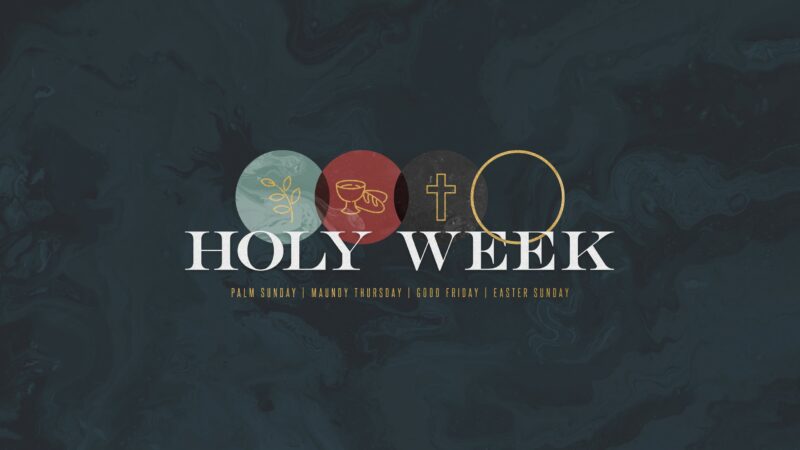
Day Four: Wednesday
Texts: (Matthew 26:6–16, Mark 14:1–11, Luke 22:3–6.)
Congratulations on making it this far. We are half-way through remembering the most important week in human history! The past several days have been a rush of activity and tension featuring Jesus’s opponents—and His unflinching resolve. On the Wednesday before his death we find Jesus is at rest. We see Him in the home of Simon the Leper when someone offers Him a costly gift. The issue in today’s devotional is the issue of “sacrifice.” How much does following Jesus cost? Of course the gospel of grace is free, but how much would you be willing to sacrifice in your commitment to the Lord? As you consider your answer to this question, let’s look closely at three scenes in Mark 14:1-11:
SCENE 1 (Mk 14:1-2)
Now the Passover and the Feast of Unleavened Bread were only two days away, and the chief priests and the teachers of the law were looking for some sly way to arrest Jesus and kill him. “But not during the Feast,” they said, “or the people may riot.” (Mk 14:1-2, NIV)
Passover is near, its only two days away. Lots of travelers were in town. There’s probably an extra 300,000 people in Jerusalem to celebrate the feast. Imagine a very chaotic environment like Mardi Gras. A crowd this size was particularly nerve racking for those in charge. Here the setting for this first scene is in a room in the temple complex somewhere, a secret meeting, with chief priests and scribes. They obviously want to put a stop to Jesus’ activities once and for all, and arrest and kill him, but they fear the response of the crowd and a potential uprising.
Skillful writer that he is, Mark switches the channel in scene 2 to begin another story before he finishes this first story later. As a technical note, one of my DTS professors Dr. Abraham Kuruvilla explained the purpose for this bracketing technique is often to draw out a contrast. We will get back to that later (in scene 3). Meanwhile, when the meeting is taking place with the Jewish leaders, where is Jesus?
SCENE 2 (Mk 14:3-9)
While he was in Bethany, reclining at the table in the home of a man known as Simon the Leper, a woman came with an alabaster jar of very expensive perfume, made of pure nard. She broke the jar and poured the perfume on his head. Some of those present were saying indignantly to one another, “Why this waste of perfume? It could have been sold for more than a year’s wages and the money given to the poor.” And they rebuked her harshly. “Leave her alone,” said Jesus. “Why are you bothering her? She has done a beautiful thing to me. The poor you will always have with you, and you can help them any time you want. But you will not always have me. She did what she could. She poured perfume on my body beforehand to prepare for my burial. I tell you the truth, wherever the gospel is preached throughout the world, what she has done will also be told, in memory of her.” (Mk 14:3-9, NIV)
During their meal together, Mary of Bethany—Lazarus’s sister (John 12:3)—comes to Jesus with an alabaster flask of very expensive perfume. Like popping the cork on the most expensive bottle of wine in the cellar, she has intentionally saved her very best as a gift for His anointing. Some present complain about her gesture, “What a shame! This is wasteful!” Why would you take something so costly and pour it out? Read that last sentence again.
Why did she do this? The answer was this woman understood Jesus’ mission, that Jesus had come to die. Though he had explained his mission to his disciples on several occasions (Mk 8:31-32, Mk 9:30-32, Mk 10:32-34), they didn’t “get it.” He is the Christ. They thought he came to rule! But the word “Christ” literally means, “the anointed one.” Jesus comes to her defense because she understood what Jesus is all about and says she has anointed Him … for His burial. He came to offer a costly sacrifice for the world.
Therefore, her perfume is a picture of Him. Do you see it? Jesus is just like that perfume, precious, broken and poured out for for the world. She understood and responded to Jesus appropriately and would always be remembered. She understood what we all need to understand:
The only appropriate response to Jesus is to give Him your all.
SCENE 3 (Mk 14:1-11)
Mark switches back to the first scene to finish the story in v 10.
Then Judas Iscariot, one of the Twelve, went to the chief priests to betray Jesus to them. They were delighted to hear this and promised to give him money. So he watched for an opportunity to hand him over. (Mk 14:10-11, NIV).
Did you notice the contrast? We have on the one hand a woman willing to sacrifice her most treasured possession, and on the other hand, a self-centered man willing to sell Jesus out for what’s in it for him. We have Judas’ incredible disloyalty contrasted with this woman’s incredible devotion. It’s in the contrast that we find the lesson for today: Which one will we be like? Will we always consider first: “What’s in it for me?” or will we think: “What can I offer to Him?” That’s the question.
Friends, the reason this is so important is that we always give generously to that which is our true God. Who or what are you really trusting in and sacrificing to? Is what you are sacrificing to worthy of your sacrifice? Offer to Jesus that which is precious, costly and generous. May your prayer be that of Judson W. Van DeVenter, a teacher familiar with making sacrifices for the Lord, who said it this way:
I will ever love and trust Him
In His presence daily live
Humbly at His feet I bow
Worldly pleasures all forsaken
Take me, Jesus, take me now
I surrender all
All to Thee my blessed Savior
I surrender all
Prayer: Lord, thank you for being broken and poured out for me. Help me to understand that the only appropriate response to your sacrifice, is to give you my all.
(If interested in watching a longer video teaching of this same story from the Gospel of Matthew, see below.)
Tomorrow we will examine the events of Maundy Thursday.
Holy Week Devotionals:




